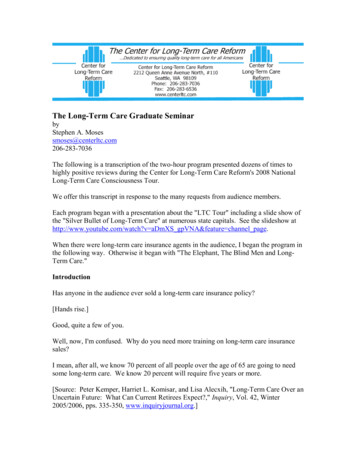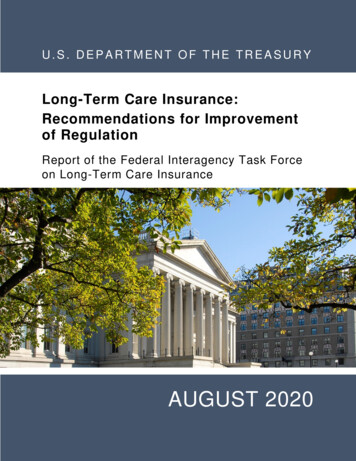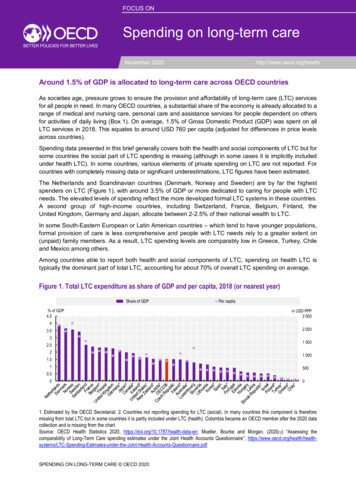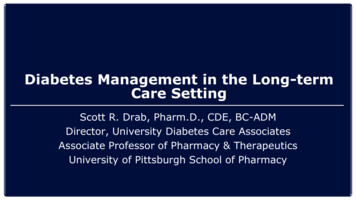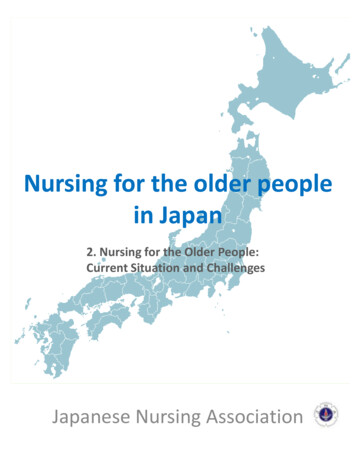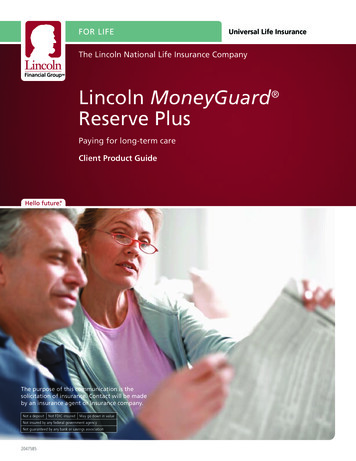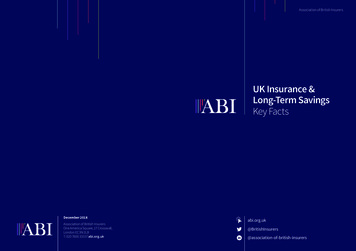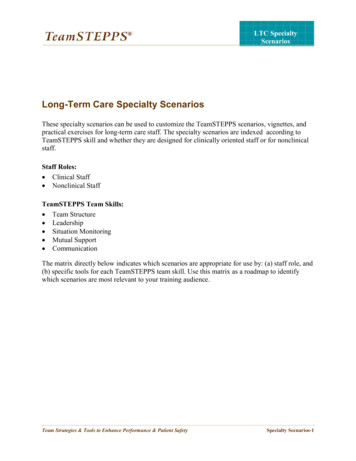
Transcription
LTC SpecialtyScenariosLong-Term Care Specialty ScenariosThese specialty scenarios can be used to customize the TeamSTEPPS scenarios, vignettes, andpractical exercises for long-term care staff. The specialty scenarios are indexed according toTeamSTEPPS skill and whether they are designed for clinically oriented staff or for nonclinicalstaff.Staff Roles:Clinical StaffNonclinical StaffTeamSTEPPS Team Skills:Team StructureLeadershipSituation MonitoringMutual SupportCommunicationThe matrix directly below indicates which scenarios are appropriate for use by: (a) staff role, and(b) specific tools for each TeamSTEPPS team skill. Use this matrix as a roadmap to identifywhich scenarios are most relevant to your training audience.Team Strategies & Tools to Enhance Performance & Patient SafetySpecialty Scenarios-1
LTC SpecialtyScenariosSPECIALTY SCENARIO MATRIXSTAFF ROLE AND CORRESPONDING SCENARIOSClinical StaffLicensed nurses, NursingAssistants, Rehabilitation Staff,Physicians, APRNs/PasNonclinical StaffAdministration, Dietary, Housekeeping,Laundry, Maintenance, Social Services,Therapeutic Recreation1, 2, 31, 2, 3LEADERSHIP44,5,6SITUATIONMONITORING7, 8, 10, 118, 9, 10, 11MUTUAL SUPPORT12, 14, 15, 17, 19, 20, 21, 22, 2313, 15, 16, 18, 19, 22, 23, 24COMMUNICATION25, 26, 27, 28, 29, 30, 31, 32, 3328, 30, 33TeamSTEPPS SkillTEAM STRUCTURESpecialty Scenarios-2Team Strategies & Tools to Enhance Performance & Patient Safety
LTC SpecialtyScenariosCUSTOMIZABLE CONTENTTeam Strategies & Tools to Enhance Performance & Patient SafetySpecialty Scenarios-3
LTC SpecialtyScenariosTeam StructureScenario 1Appropriate for:Department:Clinical and Nonclinical StaffEntire Nursing HomeA multi-team system (MTS) includes several components:Core TeamCoordinating TeamContingency TeamAncillary ServicesAdministrationExample: A Multi-Team System in a Nursing HomeHere we see an example of an MTS in a 120-bed long-term care facility. In this example, theCore team consists of: nurses (e.g., charge nurse, medication/treatment nurse), nursing assistants,restorative aides, attending physicians, and APRNs/PAs. The Coordinating Team consists of:the nursing supervisor or unit manager, unit secretary, and dietitian. The Ancillary ServicesTeam includes rehabilitation therapy staff, social services, and therapeutic recreation staff. TheSupport Services Team consists of dietary, laundry, and housekeeping. The Contingency Teamconsists of the nursing home’s emergency response team, care planning team, and qualityimprovement teams. Administration consists of the medical director, the director of nursing, andthe administrator.Specialty Scenarios-4Team Strategies & Tools to Enhance Performance & Patient Safety
LTC SpecialtyScenariosTeam StructureScenario 2Appropriate for:Department:Clinical and Nonclinical StaffAll Departments at the Unit LevelA multi-team system (MTS) includes several components:Core TeamCoordinating TeamContingency TeamAncillary ServicesAdministrationExample: A Multi-Team System on a 30-Bed Long-Term Care UnitHere we see an example of an MTS on a 30-bed long-term care unit within a 150-bed nursinghome. In this example, the Core Team consists of: nurses (e.g., charge nurse,medication/treatment nurse), nursing assistants, restorative aides, attending physicians, andAPRNs/PAs. The Coordinating Team consists of: the nursing supervisor or unit manager, unitsecretary, and dietitian. The Ancillary Services Team includes rehabilitation therapy staff, socialservices, and therapeutic recreation staff. The Support Services Team consists of dietary,laundry, and housekeeping. The Contingency Team consists of the nursing home’s emergencyresponse team, care planning team, and quality improvement teams. Administration consists ofthe medical director, the director of nursing, and the administrator.Team Strategies & Tools to Enhance Performance & Patient SafetySpecialty Scenarios-5
LTC SpecialtyScenariosTeam StructureScenario 3Appropriate for:Department:Clinical and Nonclinical StaffAll Departments at the Unit LevelA multi-team system (MTS) includes several components:Core TeamCoordinating TeamContingency TeamAncillary ServicesAdministrationExample: A Multi-Team System on the Cardiac Rehabilitation UnitHere we see an example of an MTS in the Cardiac Rehabilitation Unit. In this example, the CoreTeam consists of: the consulting cardiologist, the charge nurse, nursing assistants, and thephysical therapist. The Coordinating Team consists of the house supervisor/unit manager and thecardiac rehabilitation program manager. The Ancillary Services Team includes social services,dietary, rehabilitation therapy aides, and housekeeping. The Contingency Team consists of thenursing home’s emergency response team. Administration consists of: the medical director, thedirector of nursing, and the administrator.Specialty Scenarios-6Team Strategies & Tools to Enhance Performance & Patient Safety
LTC SpecialtyScenariosLeadershipScenario 4Appropriate for:Department:Clinical and Nonclinical StaffNursing, Housekeeping, DietaryThe second shift team working together on the secured dementia unit has been reportinggastrointestinal symptoms for multiple residents. During a huddle, the team leader identifies thatmost of the residents are sick. She informs the team that infection control and housekeeping havebeen alerted and dietary will be delivering extra fluids to the unit. The team is informed that theevening meal will be restricted to in-room dining only and group activities have been canceled.She checks in with how the team is feeling and reviews with the team the symptoms to monitor.Instructor CommentsEffective team leadership results in having team members who know their roles andresponsibilities. Essential Information is shared and feedback is sought by the leader.Skills NeededTeam structure: Identify a leader, identify goals and vision, assign roles and responsibilities,share information among team members, and provide feedback.Potential ToolsHuddle, Collaboration, Feedback, Task assistanceTeam Strategies & Tools to Enhance Performance & Patient SafetySpecialty Scenarios-7
LTC SpecialtyScenariosLeadershipScenario 5Appropriate for:Department:Nonclinical StaffDietaryThe dietary department huddles to discuss the evening’s event, a family/resident holiday meal.Everyone is invited and more than 100 attendees are expected this year. It is their biggest eventyet. During the huddle, the team leader updates the department staff on the expected attendanceand the different dining rooms and common areas that will be used for seating to accommodateeveryone. He confirms with the team their assigned dining room or common area for which theyare responsible during the event and reviews the list of tasks and duties to be accomplished. Theteam is also updated on the non-dietary staff assigned to assist with the event. The team leaderchecks in with the team for questions and clarifies erroneous information.Instructor CommentsEffective team leadership results in having team members who know their roles andresponsibilities. Essential Information is shared and feedback is sought by the leader.Skills NeededTeam structure: Identify a leader, identify goals and vision, assign roles and responsibilities,share information among team members, and provide feedback.Potential ToolsHuddle, Collaboration, Feedback, Task assistanceSpecialty Scenarios-8Team Strategies & Tools to Enhance Performance & Patient Safety
LTC SpecialtyScenariosLeadershipScenario 6Appropriate for:Department:Nonclinical StaffMaintenanceThe maintenance team gathers for a huddle during a snowstorm on the first shift. Thedepartment head updates the team on the changing weather forecast, which is now predicting upto 12 inches of snow, with the heaviest snow falling during the change of shift. The departmenthead gives the workers their assignments: shoveling, plowing, deicing walkways. He also givesthe “snow rides” assignments, which involve maintenance staff picking up other staff memberswho cannot drive to work due to the snow. The department head also checks in with the team tobe sure they have the equipment they need and proper snow gear to stay dry and warm and thattheir own families are safe.Instructor CommentsEffective team leadership results in having team members who know their roles andresponsibilities. Essential Information is shared and feedback is sought by the leader.Skills NeededTeam structure: Identify a leader, identify goals and vision, assign roles and responsibilities,share information among team members, and provide feedback.Potential ToolsBrief, Huddle, Collaboration, Feedback, Task assistanceTeam Strategies & Tools to Enhance Performance & Patient SafetySpecialty Scenarios-9
LTC SpecialtyScenariosSituation MonitoringScenario 7Appropriate for:Department:Clinical StaffNursingMary, a nursing home resident, falls while trying to walk independently. She suffers a headlaceration and a possible fractured hip. The nursing assistant, charge nurse, and supervisor allrespond to Mary’s cry for help. Jean, the supervisor, completes her assessment. She directs Ann,the nursing assistant, to retrieve 4x4 gauze from the treatment cart and tells Jerri, the chargenurse, to maintain C-spine precautions until EMS arrives. Noticing her confused expression,Jean tells Jerri, “Place one hand on each side of Mary’s head and keep it in straight alignmentwith her spine.”Instructor CommentsReinforce the point that monitoring of both the resident and team members supports themaintenance of situation awareness. In this case, it involves observing others and using clearcommunication. Monitoring is a powerful agent in responding proactively to a situation.Skills NeededSituation monitoring: Assess status of resident and team and progress toward the goal. Crossmonitoring.Potential ToolsCall-out, Task assistance, CollaborationSpecialty Scenarios-10Team Strategies & Tools to Enhance Performance & Patient Safety
LTC SpecialtyScenariosSituation MonitoringScenario 8Appropriate for:Department:Clinical and Nonclinical StaffEntire Nursing HomeA powerful storm has downed trees and power lines across the city. A fallen tree has blockedthe main road to and from the nursing home, preventing anyone from leaving or coming to work.Everyone is pitching in to help where they can. Social workers are passing water pitchers andafternoon snacks. A nursing assistant is leading an impromptu sing-a-long with a group ofresidents. Nurses are assisting with toileting, and housekeepers and administration are answeringcall bells. The director of nursing and assistant director of nursing are rounding and offeringsuggestions on what staff can do to help on the various units and offering assistance as needed.Instructor CommentsAll staff are using situation monitoring to assess the status of the residents and the team.Everyone has put the safety of the residents ahead of their usual roles and responsibilities.Skills NeededSituation monitoring: Assess status of residents and team and progress toward the goal.Mutual support: Provide task-related support and verbal support. Communication: Offerinformation.Potential ToolsTask assistance, Collaboration, Cross-monitoringTeam Strategies & Tools to Enhance Performance & Patient SafetySpecialty Scenarios-11
LTC SpecialtyScenariosSituation MonitoringScenario 9Appropriate for:Department:Nonclinical StaffHousekeepingMary, a housekeeper, walks onto Unit 3 to get some extra supplies when she notes that Carol, theUnit 3 housekeeper rushing down the hall. Mary asks Carol what is the problem, and she states,“I have a flood in the Room 316 bathroom and it is heading into the hallway. Mary states shewill call maintenance and will be down in a moment to place caution signs in the hallway andalert the staff. Carol says, “thank you,” as she heads into the room to deal with the issue. Maryalerts everyone she needs to and then checks with Carol to make sure everything is under controlprior to leaving the unit.Instructor CommentsIn this scenario, Mary goes out of her way to assist a fellow team member deal with a crisis.She is aware of the environment, changes her priorities to prevent a flood and potential injuryto other staff members and residents, keeping her goal to ensure resident safety in focus.Skills NeededTask assistance. Shared mental model. Communication.Potential ToolsCollaboration, Task assistance, Cross-monitoringSpecialty Scenarios-12Team Strategies & Tools to Enhance Performance & Patient Safety
LTC SpecialtyScenariosSituation MonitoringScenario 10Appropriate for:Department:Clinical and Nonclinical StaffEntire Nursing HomeThe STEP process involves ongoing monitoring of the:Status of the resident.Team members.Environment.Progress toward the goal.Example:The social worker notes that a resident in the end stages of Alzheimer’s disease shows facialgrimacing and restlessness. She thinks this could indicate an increased level of pain that cannotbe communicated (STATUS).The resident’s nurse is busy helping another resident (TEAM MEMBERS).It is shift change, and everyone is busy, so the social worker checks the medication record andnotes that the resident is overdue for his morphine (ENVIRONMENT).The social worker notifies the incoming nurse of her concern (PROGRESS).Team Strategies & Tools to Enhance Performance & Patient SafetySpecialty Scenarios-13
LTC SpecialtyScenariosSituation MonitoringScenario 11Appropriate for:Department:Clinical and Nonclinical StaffEntire Nursing HomeThe STEP process involves ongoing monitoring of the:Status of the resident.Team members.Environment.Progress toward the goal.Example:The dietary aide is on the first floor delivering snacks when she notices a resident attempting towheel herself out the front door. The dietary aide puts her snacks down and asks the resident ifshe needs help. The resident responds with a very confused answer that does not make any sense(STATUS).The aide looks around to see if any nursing staff are around. Not seeing any staff, she asks theresident if she could help her back to the unit. Upon return to the unit, the aide realizes all thestaff are providing care. She takes the resident into the dining room with her and helps her to atable (TEAM MEMBERS).The aide goes down the hallway and finds the therapeutic recreation director. She explains herconcerns. The therapeutic recreation director takes the resident into a program that was justgoing to start (ENVIRONMENT).The aide finishes delivering the snacks and checks on the resident, who is now in the groupactivity smiling and singing (PROGRESS).Specialty Scenarios-14Team Strategies & Tools to Enhance Performance & Patient Safety
LTC SpecialtyScenariosMutual SupportScenario 12Appropriate for:Department:Clinical StaffNursingTwo nursing assistants are at the desk during a brief lull in a busy shift. They notice anothernursing assistant racing busily between resident rooms and the supply area, glancing over atthem as she passes. Nursing Assistant #1 says to Nursing Assistant #2, “Let's see if Maureen canuse some help.” Nursing Assistant #2 replies, “My resident will be back from rehab in just a fewminutes, and I hate to get tied up. Besides, Maureen doesn't usually accept help from anyone.”“Come with me,” says Nursing Assistant #1. “I’ll show you how it's done.” Nursing Assistant#1 approaches Maureen and says, “Maureen, I can see you're busy. I have about 5 minutes beforemy resident gets back from rehab. I can take Mr. Rappaport and Mrs. Papa to the morningcoffee and news program for you if that helps.” “Thanks,” says Maureen, “that would be great.They love to go and the program is starting shortly. Now I can help Mrs. Cortes finish gettingready for her doctor’s appointment.”After Maureen leaves, Nursing Assistant #1 says to Nursing Assistant #2, “The key to offeringassistance is being clear about how much time you have and what tasks you're able to pick up.”Instructor CommentsIn this scenario, Nursing Assistant #1 demonstrates that clear communication about timeavailability and specific assistance offered facilitates successful task assistance. Situationawareness and situation monitoring are combined with mutual support to reinforce ateamwork skill through peer coaching.Skills NeededTask assistance. Situation awareness. Situation monitoring. Communication.Potential ToolsFeedback, Collaboration, Delegation, Cross-monitoringTeam Strategies & Tools to Enhance Performance & Patient SafetySpecialty Scenarios-15
LTC SpecialtyScenariosMutual SupportScenario 13Appropriate for:Department:Nonclinical StaffSocial ServicesA resident with dementia had been admitted to the short-term unit for rehab after a hip fractureand is now being transferred back to her assisted living facility. The social worker for the shortterm care unit has discussed this move with the resident’s family and they are in agreement.When the time comes to transfer the resident and her belongings, another resident on the unitbegins making suicidal threats and the short-term social worker is paged to the resident’s room.The social worker from the long-term care unit walking in the vicinity of the short-term unithears the page and offers to take over the transfer of the resident.Instructor CommentsIn this scenario, the short-term unit social worker steps in to assist in a crisis situation. She isaware of the environment and adjusts her priorities to help ensure that the resident has asmooth transition from the current care area to the next, all the while maintaining the goal toensure resident safety.Skills NeededTask assistance. Situation awareness. Situation monitoring: Assess environment.Communication.Potential ToolsTask assistance, Feedback, CollaborationSpecialty Scenarios-16Team Strategies & Tools to Enhance Performance & Patient Safety
LTC SpecialtyScenariosMutual SupportScenario 14Appropriate for:Department:Clinical StaffNursingA staff development nurse watches a nursing assistant use a mechanical lift to transfer aresident from the bed to a chair. The nurse pulls the nursing assistant aside and reminds thenursing assistant on the proper positioning of the lift pad, showing the nursing assistant whichlandmarks to use. She explains how the resident’s position can affect the function of the lift andcan also cause friction and sheer to the resident’s skin when not positioned properly.Instructor CommentsIn this scenario, situation awareness and situation monitoring are combined with mutualsupport to reinforce a teamwork skill through situational learning.Skills NeededSituation awareness. Situation monitoring: Assess environment. Communication: Offerinformation.Potential ToolsCollaboration, Huddle, Feedback, Task assistance, Cross-monitoringTeam Strategies & Tools to Enhance Performance & Patient SafetySpecialty Scenarios-17
LTC SpecialtyScenariosMutual SupportScenario 15Appropriate for:Department:Clinical and Nonclinical StaffAdministration, Social ServicesThe administrator, director of nursing, and social worker are meeting with a resident’s family todiscuss a recent complaint. The social worker addresses the family’s concerns and feelings andoffers a solution. The family feels their concerns were both heard and addressed to theirsatisfaction. After the family leaves, the administrator praises the social worker for remainingcalm with the angry family, addressing their concerns related to both facts and feelings andoffering a solution that worked for all involved.Instructor CommentsThe administrator provided feedback that was timely, specific, related to behavior, andconsiderate.Skills NeededCommunication. Mutual support. Team structure.Potential ToolsAdvocacy and assertion, Feedback, Conflict resolution, Collaboration, DebriefSpecialty Scenarios-18Team Strategies & Tools to Enhance Performance & Patient Safety
LTC SpecialtyScenariosMutual SupportScenario 16Appropriate for:Department:Nonclinical StaffDietaryA dietary director is watching the food service line and notes that the staff member assigned tocomplete the tray check is only looking at the diet and not the adaptive equipment. The dietarydirector takes the opportunity to explain the importance of not only making sure that the correctdiet is on the tray but also ensuring that the resident has all the special tools he or she needs tothis meal by him/herself. The staff member did not realize the importance of including adaptiveequipment, as he thought extra supplies were kept on the unit.Instructor CommentsA strong team structure uses feedback to improve future performance. In this case, a transferof knowledge has occurred through the processes of situational teaching and learning. Theuse of feedback will improve the knowledge base of the team in a supportive environment. Italso improves the quality of awareness that this worker will have in future situationsinvolving adaptive equipment.Skills NeededTeam structure. Communication. Mutual support. Cross-monitoring.Potential ToolsDebrief, Collaboration, FeedbackTeam Strategies & Tools to Enhance Performance & Patient SafetySpecialty Scenarios-19
LTC SpecialtyScenariosMutual SupportScenario 17Appropriate for:Department:Clinical StaffNursing, MedicineA resident on the subacute unit has been cleared for discharge following a myocardial infarction3 weeks ago. Before discharge the nurse checks the resident’s vital signs one last time. Thenurse finds it unusual that the blood pressure and heart rate are substantially elevated. Despiteconcerns, the nurse discharges the resident because the attending physician said he is wellenough to go home. Besides, the attending physician is also the facility’s medical director. He iswell respected at the facility.Instructor CommentsIn this scenario, the nurse fails to advocate for the resident. He misses an opportunity toavoid a potential complication in the resident’s condition, thus putting the resident’s safety injeopardy. Failure to advocate for the resident is frequently identified as a primary contributorto clinical errors.Skills NeededMutual support: Conflict resolution. Communication. Situation monitoring. Situationawareness.Potential ToolsAdvocacy/assertion, Two-challenge rule, CUS, DESC scriptSpecialty Scenarios-20Team Strategies & Tools to Enhance Performance & Patient Safety
LTC SpecialtyScenariosMutual SupportScenario 18Appropriate for:Department:Nonclinical StaffDietaryA high school senior working in the dietary department is wheeling the steam-tray table downthe hall after dinner. Ahead of her she sees a nursing assistant escort a resident into his room andclose the door. As she passes the room, she hears a raised voice and believes it to be the nursingassistant. She feels she should knock on the door or tell someone, but doesn’t. She says toherself, “No, I’m just in high school and working in the kitchen. It’s not my place. Plus, whowould believe me?”Instructor CommentsThis scenario illustrates that everyone on the resident care team has an obligation to advocatefor the resident. Team members should always feel their input is valued, regardless of theirlevel in the organization, age, or education.Skills NeededMutual support. Communication. Situation monitoring. Situation awareness.Potential ToolsAdvocacy/assertion, Two-challenge rule, CUSTeam Strategies & Tools to Enhance Performance & Patient SafetySpecialty Scenarios-21
LTC SpecialtyScenariosMutual SupportScenario 19Appropriate for:Department:Clinical and Nonclinical StaffSocial Services, NursingAnn Tayner is the social worker assigned to work on a busy subacute rehabilitation unit. Sherecently attended an educational session on resident safety and the importance of hand washing.She noticed that the APRN, Joyce Tsu, went from resident to resident without washing herhands. Later that morning, she encounters APRN Tsu in the corridor and addresses her, sayingthat she attended the hand-washing seminar and noticed that Ms. Tsu did not always followprocedure. APRN Tsu appears surprised by the comment but sheepishly agrees that handwashing is very important and she will be more careful.Instructor CommentsPoint out that challenging a team member’s position is an integral part of teamwork. Allmembers of the team and support staff have a responsibility to advocate for resident safetyeven if it may lead to a conflict or differing positions. In this case, situation awareness wasused to identify the problem and advocate for the residents.Skills NeededSituation awareness. Situation monitoring: Assess environment. Mutual support: Resolveconflict. Communication: Offer information.Potential ToolsAdvocacy/assertion, FeedbackSpecialty Scenarios-22Team Strategies & Tools to Enhance Performance & Patient Safety
LTC SpecialtyScenariosMutual SupportScenario 20Appropriate for:Department:Clinical StaffNursingA nurse and nursing assistant are conducting a skin assessment on a newly admitted resident.The nursing assistant thinks she sees a reddened area on the coccyx that the nurse may havemissed. What should she say?Possible Answers:Opening: Say the person’s name to whom the concern is addressed: “Dianne ”State concern: An owned emotion: “I thought I saw redness on the coccyx as we were turningMrs. Levine over.”State the problem: Real or perceived: “I can’t be certain but it looks like she may have areddened area.”Offer a solution: “I can help you turn her back over to recheck the area.”Obtain an agreement: “When she is turned, I can show you the area that I thought lookedreddened.”Instructor CommentsIn this scenario, the nursing assistant, using cross-monitoring and situational awareness,should question the nurse when she is concerned about a missed reddened area. The possibleanswers provide a structure for such a conversation.Skills NeededMutual support. Communication. Situation awareness.Potential ToolsAssertive statement, Two-challenge ruleTeam Strategies & Tools to Enhance Performance & Patient SafetySpecialty Scenarios-23
LTC SpecialtyScenariosMutual SupportScenario 21Appropriate for:Department:Clinical StaffNursingA subacute resident is receiving IV therapy and rehabilitation for an infection in her right kneejoint. The nursing assistant places a blood pressure cuff on the resident’s arm that has the centralcatheter line. The nursing assistant realizes the IV line is in this arm and stops. As she removesthe cuff, the nurse, seeing what she has done, reprimands her in front of the resident, statingabruptly, “You can’t take a blood pressure in that arm! The resident has an IV in that arm.” Thenursing assistant is embarrassed but does not speak to the nurse about the situation.Later that day, the same nurse asks another nursing assistant for an update on one of hisresidents. The nursing assistant proceeds with the update but is unable to recall the resident’sintake at breakfast and lunch. Another nursing assistant who knows this information because shetoo worked in the dining room chooses not to share it with the nurse for fear he will reprimandher for interrupting.Instructor CommentsPoint out that challenging a team member’s position is an integral part of teamwork. Everyattempt must be made to resolve personal conflict as it will interfere with work andundermine quality and resident safety.Ineffective team leadership results in having team members who do not speak up orchallenge when appropriate. In this case, mutual support is lacking; however, skill in conflictmanagement could enhance team development.Effective teams resolve conflicts constructively rather than allowing interpersonal issues topersist without resolution. Failure to share information has a detrimental effect on residentcare and may result in inadequate plans of care.Skills NeededTeam structure: Identify barrier to team effectiveness. Mutual support.Potential ToolsCollaboration, DESC script, Conflict resolutionSpecialty Scenarios-24Team Strategies & Tools to Enhance Performance & Patient Safety
LTC SpecialtyScenariosMutual SupportScenario 22Appropriate for:Department:Clinical and Nonclinical StaffMaintenance, NursingA maintenance request to fix a window unit air conditioner was submitted 2 days ago by thecharge nurse. While in the resident’s room, the nurse realizes it is warm and the air conditionerstill isn’t working properly. She checks the logbook and sees that the maintenance request hasnot been completed. She does not know that a new unit is being delivered today. Worried aboutthe comfort of her resident, who has difficulty breathing in warm weather, she raises her voice atthe director of maintenance in front of staff and residents, criticizing his work ethic.DESC:D “I (maintenance director) realize that you (nurse) are worried about the resident’s abilityto breathe comfortably in this warm weather and I am sensing that you don’t think I haveaddressed your concern about her air conditioning problem.”E “When you accuse me of not addressing the needs of residents, especially in a timelyfashion, it embarrasses me and makes me very frustrated.”S “If you have a question about my performance, I would appreciate your asking me aboutit before jumping to conclusions.”C “Having a conversation with me would be better because I would feel less embarrassedand would be able to supply information. Can we agree to follow such a procedure if thishappens again? In the meantime, I can add a “pending” column to the logbook tocommunicate such information.”Instructor CommentsThis example shows a good approach to conflict resolution and use of the DESC script.Skills NeededCommunication.Potential ToolsConflict resolution, DESC scriptTeam Strategies & Tools to Enhance Performance & Patient SafetySpecialty Scenarios-25
LTC SpecialtyScenariosMutual SupportScenario 23Appropriate for:Department:Clinical StaffNursingA nurse feels that a resident has abdominal distension and pain secondary to a distended bladderand needs a catheter. The nurse calls the attending physician
CUSTOMIZABLE CONTENT . Specialty Scenarios-4 Team Strategies & Tools to Enhance Performance & Patient Safety LTC Specialty Scenarios Team Structure Scenario 1 Appropriate for: Clinical and Nonclinical Staff Department: Entire Nursing Home A multi-team system (MTS) includes several components:


